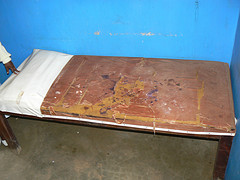
“I recently had the opportunity to visit the Msipe Heath Center, and now I have a better view of what they need, and how they are using the resources we have sent to them. On our trip to the facility we noted the roads were nearly empty, as most of the vehicles were sitting at empty fuel stations waiting for some unsure moment when more fuel will arrive. The fuel shortage in the nation is critical, and it is affecting all movement.”
“With a sufficient reserve of fuel in our tank we made our way to this 39-year-old facility, arriving at mid-morning. The buildings house maternity, general medical, nutrition, and outpatient. As we entered the facility most of the staff were quite busy caring for patients. The sister nurse in charge escorted me around, and shared the challenges they are facing. We passed the dressing room, and the consultation room (this later room also serves as the drug store). They were nearly empty, and looked hungry for supplies. The exam room was so old that it should not even carry that name. The nurse pointed it out with some regret.”
“I learned this facility serves a population area of 27,000 people, (the original plans were for it to serve only 10,000 people). It faces a continual challenge with supply shortages. As fast as we deliver, they use them for patient care. Msipe is near the top of our list of facilities receiving aid. This is true for several reasons.”
One is the fact they are using the supplies to help the very, very poor. This is a major reason we choose these types of facilities to receive aid. Second, if we can outfit these rural facilities with supplies the people will attend close to home and not overload the district facilities who are overwhelmed each time the rural facilities run out of supplies. Third, it is in a rural area. When these facilities run out of drugs people are forced to walk, cycle, or go by ox-cart to other facilities. There is a high chance that by the time they get there these other facilities will also be out of supplies.”
The trip through the facility begins to draw to a close, and Tembo concludes his report.
“The nurse said to me, ‘Our challenges are many. We generally lack drugs, gloves, exam couches, beds and mattresses, among other things.’ I noted this facility has only one medical assistant and four nurses. They are delivering 60 babies a month, and they admit 30 patients a week.”
By Wilson Isaac Tembo
